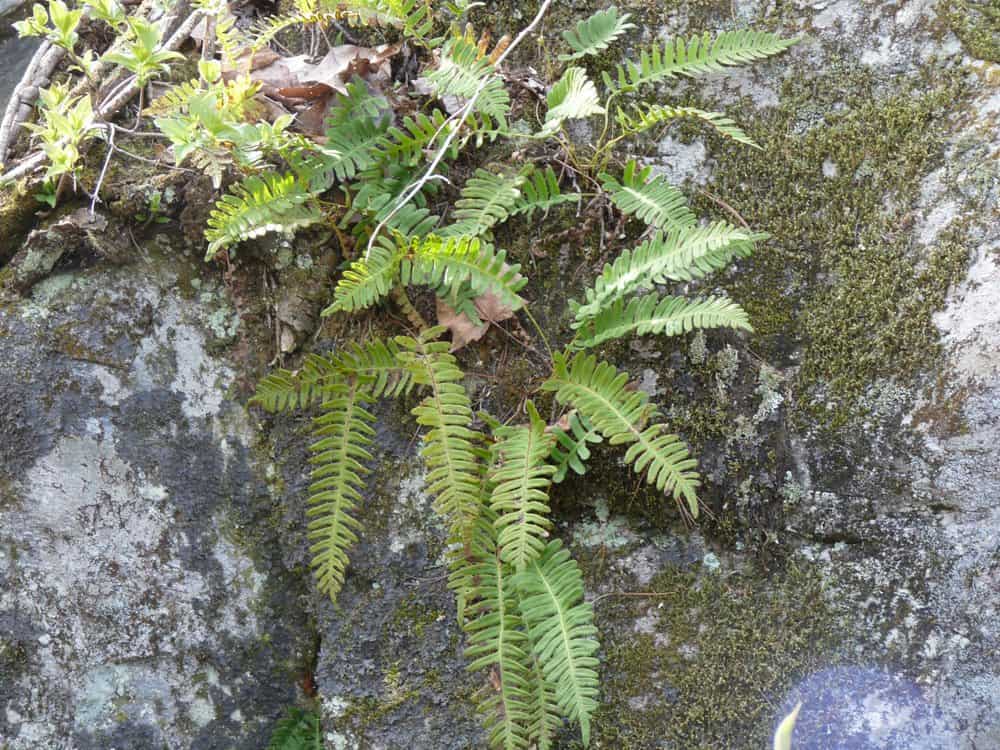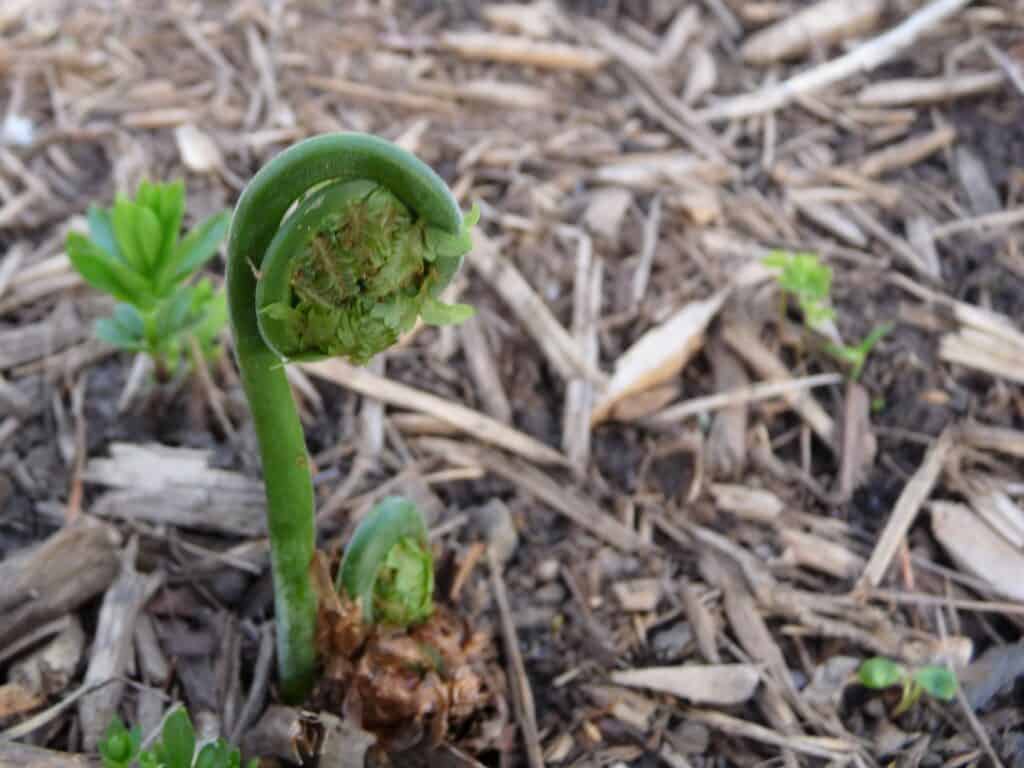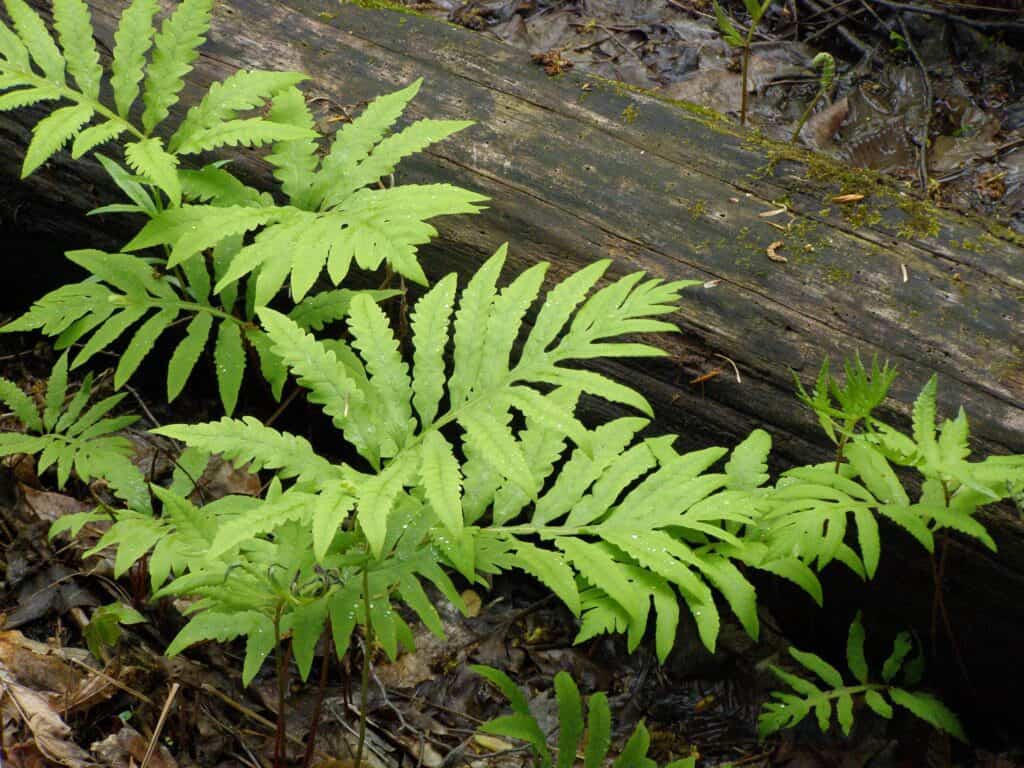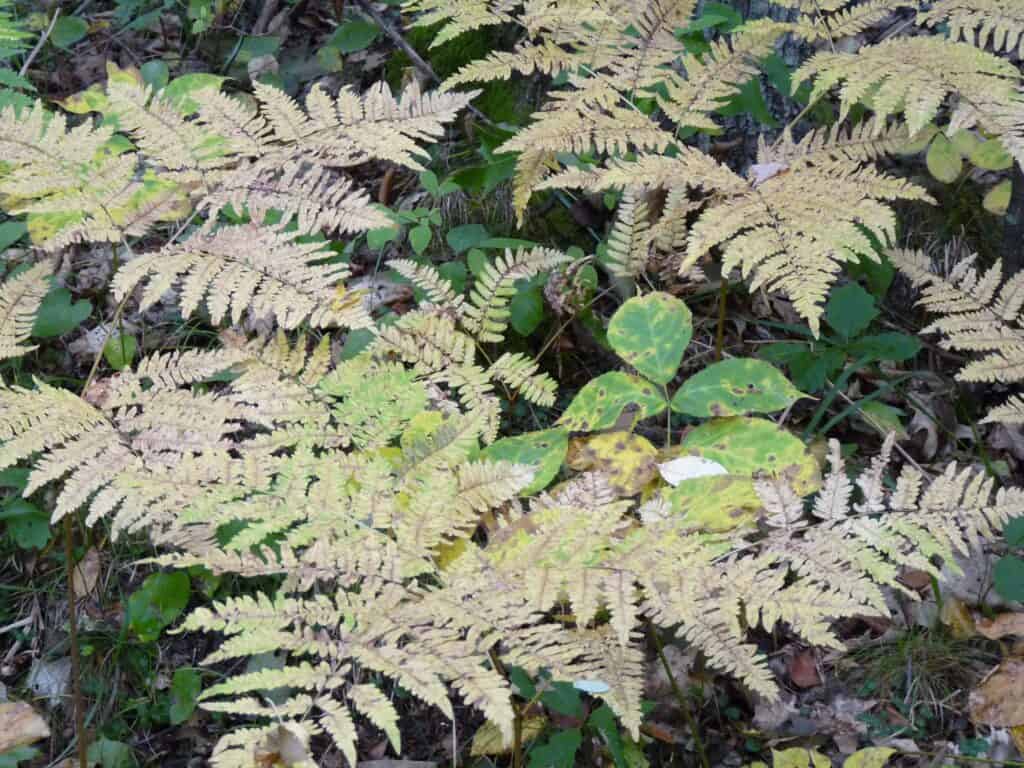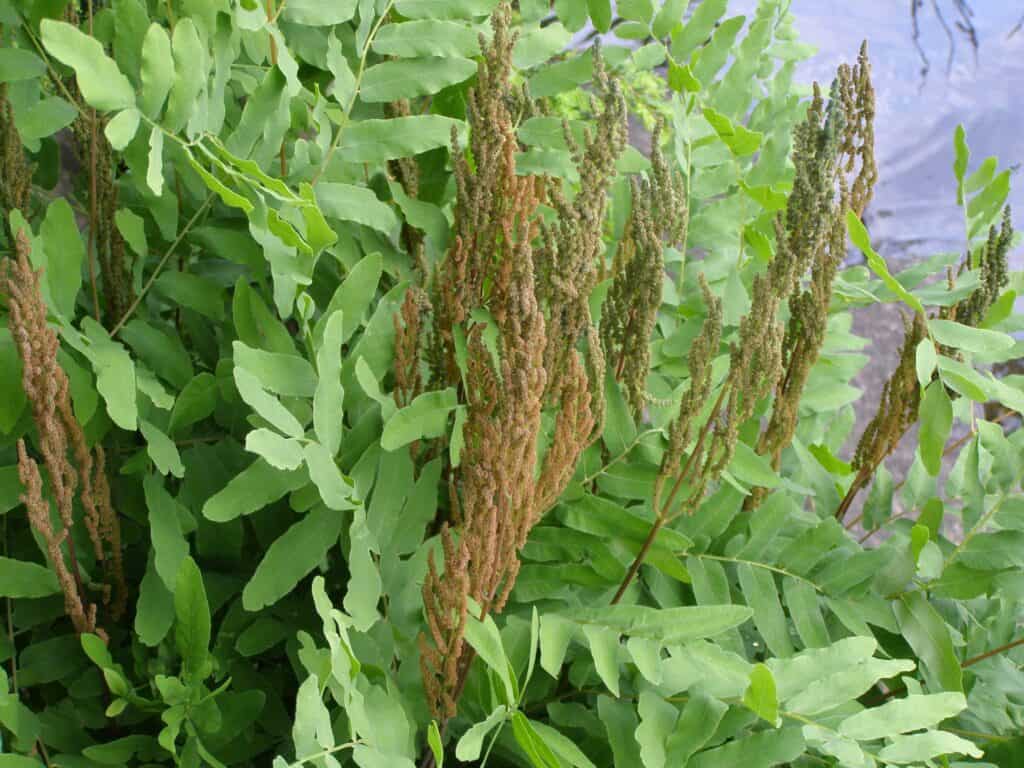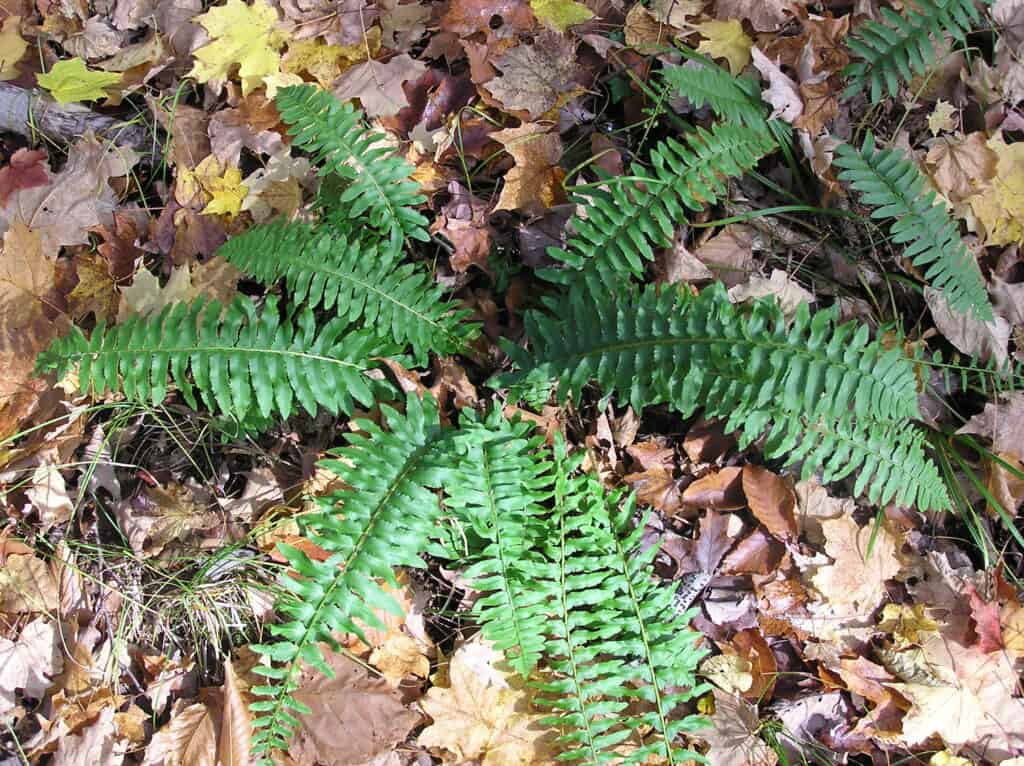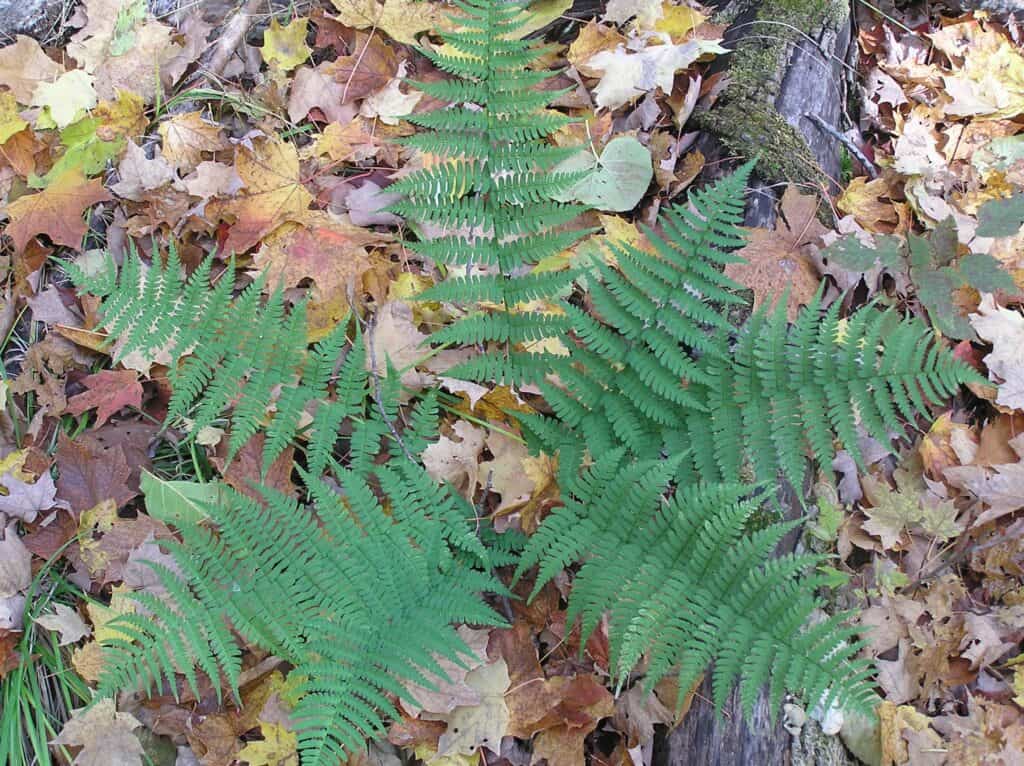It’s easy to tune out the commonplace in our flora and let it become part of the “green blur”. This is especially true when it comes to ferns, which are among the most common plants you’re likely to encounter on a forest or wetland walk. However, just recognizing and paying attention to the more common species adds so much to an enjoyment of plant life. Although their beauty can be admired from a distance as they soften a forest or rocky landscape, a true appreciation requires stopping and taking a close look at their distinctive features. With more than 40 species in Peterborough County alone, we live in a veritable fern paradise. And, there’s no better time to get to know them than right now in mid-summer.
An exchange of emails earlier this summer renewed my interest in these under-appreciated plants. Sue Paradisis, a long-time member of the Peterborough Field Naturalists, emailed to tell me of the 17 species she’d found along a short section of the Lakeshore Trail in Silent Lake Provincial Park. She added, “My mission to learn to identify ferns only began a couple of years ago, so I’m still an eager student excited by a new identification. There’s a dozen species I’m very comfortable knowing, such as distinctive ones like sensitive or maidenhair ferns. Those with more subtle differences like lady and intermediate ferns still require closer observation.”
Another friend, Mitch Brownstein, is also smitten by these graceful plants. We therefore decided to drive up to Silent Lake with fellow naturalist Brian Wales to put our identification skills to the test and see how many of Sue’s 17 species we could find.
The spectacle of fern diversity along the Lakeshore Trail was wonderful. The delicate lace of the leaves was a feast for the eyes, as was the panoply of different shades of green and the variety of size, form, and texture. Some species were growing on the ground in deep shade, others in full sun, and still others clinging to rocks or gracing the edge of the stream. It was stunning to see how the multiple fern beds reflected the sunlight filtering down from the forest canopy, instilling a deep sense of tranquility.
All the while, I tried to keep in mind that ferns have been around for at least 400 million years and are among the oldest living land plants. I could almost imagine a baby dinosaur peering out from between the fronds. Predating flowering plants, a fern’s life cycle has two parts. The spores released by the fronds are not like seeds. In other words, they don’t grow directly into new ferns. Rather, they become tiny, heart-shaped plant structures called gametophytes, which release sperm and egg cells. With the aid of water (a throwback to their ancient origin), the sex cells fuse and become a fern.
Although we didn’t find all of the species Sue had recorded – long beech fern will have to wait for another trip – we found wonderful beds of less common species like cinnamon, interrupted, and oak ferns. The latter was a new species for all of us. We’d been checking the book for the field marks of oak ferns when Brian noticed several of them at our very feet. My favourite field guide is “Ferns of Northeastern and Central North America”, by Boughton, Farnsworth, and Lowe.
Identification
Although I felt I knew the answer, I still had to ask Sue why she finds ferns so enchanting. “Ferns are so graceful and elegant. In my mind they are the signature plants of the cool and shady forest floor. They are also relatively easy to learn, as there aren’t that many varieties. And, unlike birds, they stay put!”
So, where does one begin when identifying ferns? The starting point is the leaves – or “fronds”. These are the main stems (axis) with green, leaf-like growth. Are they big (maybe a metre or more) or small (less than 30 cm)? Are they coarse and heavy or delicate and lace-like? Are they triangular, oval-shaped, or long and narrow? Often, paying attention to features such as these is enough to identify the species.
Sue also recommends learning about “divisions” and finding examples of each. In once-divided ferns, the green growth along the frond’s axis – usually referred to as pinnae or leaflets – is stubby or finger-like (e.g., common polypody). In twice-divided species, the leaflets are cut up into sub-leaflets (e.g., ostrich fern). Finally, in thrice-divided ferns, the sub-leaflets themselves are cut up when you look closely (e.g., spinulose woodfern). This gives them a lacy or feathery look.
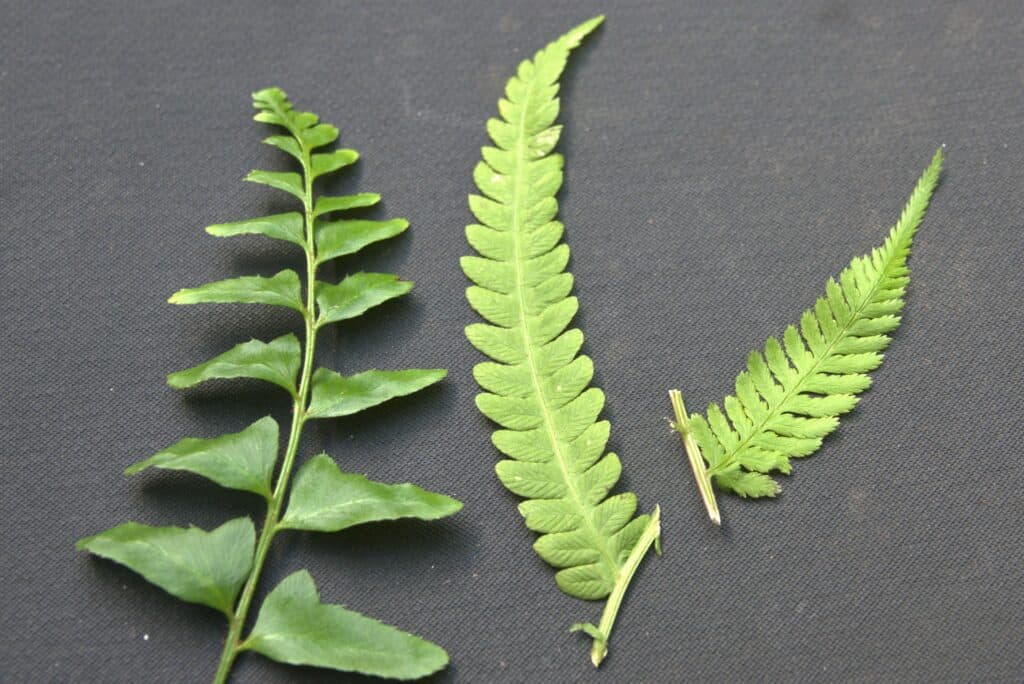
Next, look for where the spores are housed.Often, they dwell in pinhead-sized structures called sori or “fruit dots” on the underside of the leaflets. The sori can differ in colour, shape, and location, depending on the species. In marginal woodfern, for example, they are round and along the edge (margins) of the sub-leaflets.
Sometimes, the spores are located in structures on separate stalks called fertile fronds. These are often dark, stout and plume-like with stubby “branches”, totally absent of green growth. To clinch the identification, you might also need to check out the texture and colour of the axis and stalk (base) of the fern.
Seven species to learn
1.Ostrich fern (Matteuccia struthiopteris): Large (up to 1.5 m), twice-divided, with several gracefully arching fronds. Look for one or more short, dark, fertile fronds, which suggest an ostrich feather. They grow along streams or in low, damp, open woodlands. This is the familiar fiddlehead fern. The frond is edible before it unfurls.
2. Sensitive fern (Onoclea sensibilis): Medium (50 – 70 cm), once-divided. Look for dark fertile fronds with bead-like spore cases. They are usually found in damp or wet places, both in sun and shade.
3. Common polypody (Polypodium virginianum): Small (less than 30 cm), leathery, deep green, and once-divided. Look for round, red-brown sori on they upper leaflets. Polypody usually grows on rocks.
4. Bracken (Pteridium aquilinum): Medium to large (up to 1m), coarse, fronds divided into three triangular parts with lower parts opposite. The sori are near the margins of the sub-leaflets. Bracken is very common and grows in poor soils along roadsides and in forest clearings
5. Royal fern (Osmunda regalis): Large (up to 1.5 m), twice-divided, pale-green, with leaflets that look like the compound leaves of a locust tree. Some of the green fronds are crowned (hence the name “royal”) by clusters of rusty-coloured spore cases. They are found along creeks and shorelines of lakes.
6. Marginal (evergreen) woodfern (Dryopteris marginalis): Medium to large (up to 1m), with six or more leathery, dark green fronds in graceful clumps. The fronds are twice-cut, have sori along the margins of the leaflets, and remain green all year long. This is an abundant fern of woodlands. The similar spinulose (“having small spines”) woodfern is thrice-cut and lacy.
7. Christmas fern (Polystichum acrostichoides): Medium to large (up to 1m), once-cut, with leathery, tapering fronds in circular clumps, which stay rich-green all year long. The numerous sori are red-brown and often cover the bottom-side of the upper leaflets completely. Look for them on rocky, shaded slopes in woodlands.
Where to go
Ferns are everywhere. However, I have a special fondness for the Stoney Lake Trails at Viamede and the Nanabush Trail at Petroglyphs Provincial Park. Sue also recommends the following locations.
1. Warsaw Caves Conservation Area: Take the Kettles Trail from the parking lot to the river. Ferns are abundant on the limestone boulders and cliffs. Watch for common polypody and the rare walking fern. This small (15 cm), evergreen fern has long, narrow, fine-pointed leaves. New plants sprout where the tips touch the ground, hence the name “walking”. Also look for Christmas ferns and both marginal and spinulose woodferns.
2. Silent Lake Provincial Park: Walk the Lakeshore Trail from the day-use beach to the canoe dock. Among the 17 or more species along this trail, you’ll find sensitive, royal, maidenhair, New York, oak, cinnamon, interrupted, long beech, and bulblet ferns.
3. Mark S. Burnham Provincial Park: The main trail is a great place to see maidenhair, Christmas, ostrich, and lady ferns.
4. Jackson Park: From the Monaghan Road parking lot, follow the wide, road-like path down the hill. Just before the concrete bridge, take the trail to the left. You’ll find large numbers of sensitive, ostrich, royal, and woodferns. Small, dainty, yellow-green bulblet ferns also grow on the ground in shady spots all along Jackson Creek.
Remember, too, that ferns are easy to grow and look wonderful in shaded gardens. I have planted more than a dozen species, all of which are thriving, even though many are not in their typical habitats. It’s wonderful to enjoy these intriguing, ancient plants almost at my doorstep.
CLIMATE CRISIS NEWS
ALARM: Scientists have now determined that the unprecedented heat wave we just experienced is another manifestation of climate change. Human-caused warming of the Arctic has resulted in a weakened Jet Stream. This is the high-altitude wind that pushes around air masses and affects weather patterns. The Jet Stream has become “loopy” (like an S laying on its side), locking in weather systems for weeks on end. BC has been cool and wet, while points east have suffered from extreme heat. The same phenomenon explains the devastating fires in Siberia.
ENCOURAGEMENT: Joe Biden has just released a $2 trillion plan to boost investment in clean energy and stop all greenhouse gas emissions from U.S. power plants by 2035. He argues that dramatic action of this kind addresses both climate change and reviving the economy.
For local climate news and ways to take action, visit https://forourgrandchildren.ca/ and subscribe to the newsletter.
